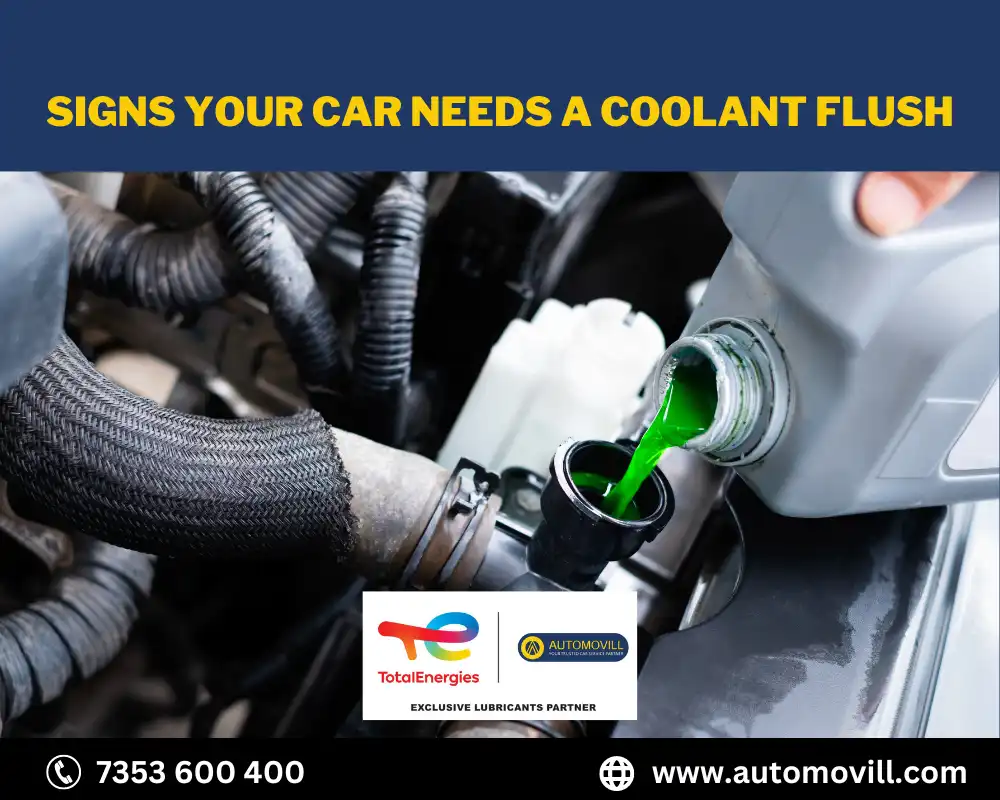
Regular maintenance is the key to keep your car running smoothly and prevent potential damage. Along with regular maintenance, how you drive and in which condition, also play a big role in keeping the engine healthy. One essential aspect of maintenance is the coolant flush, which involves replacing the old coolant with fresh fluid.
In this blog, we will explore the signs that indicate your car may require a coolant flush, why it is necessary to maintain the cooling system, and the steps to perform a coolant flush.
Signs Your Car Needs a Coolant Flush
Here are the possible signs that indicate your car needs a coolant flush:
1. Engine Overheating:
- The most obvious sign is an engine that consistently runs hot, with the temperature gauge reaching or exceeding the red zone.
- Overheating can cause severe engine damage, making it crucial to address the issue promptly by checking and flushing the coolant system.
2. Rusty or Discolored Coolant:
- During routine inspections, check the color and condition of your coolant.
- If the coolant appears rusty or discolored, it may indicate contamination or aging, suggesting the need for a coolant flush.
3. Low Coolant Level:
- A noticeable drop in the coolant level in the reservoir or radiator could indicate a coolant leak or excessive evaporation.
- Consistently needing to add coolant to maintain the proper level is a sign that your car’s cooling system requires attention, including a potential coolant flush.
4. Coolant Contamination:
- Contaminated coolant loses its effectiveness in protecting the engine from corrosion and overheating.
- Signs of coolant contamination include oil or fuel mixing with the coolant, creating a milky or foamy appearance.
- If you observe such contamination, promptly address it, which may involve a coolant flush.
5. Old Coolant Age:
- Over time, coolant deteriorates, losing its ability to regulate engine temperature effectively.
- If you’re uncertain about the age or condition of the coolant in your car, get it inspected by a mechanic
- Regular coolant flushes are typically recommended every two to five years, depending on the manufacturer’s guidelines.
6. Temperature Fluctuations:
- Erratic temperature fluctuations on the gauge, going from normal to high and back, could indicate a problem with the cooling system.
- A coolant flush can help eliminate blockages or air pockets in the system that may cause these irregular temperature fluctuations.
7. Unpleasant Odors or Steam:
- A strong, sweet odor inside or outside the car, particularly near the engine compartment, can indicate a coolant leak.
- Additionally, if you observe steam or white smoke coming from under the hood, it may be a sign of a coolant leak or overheating.
- These signs should not be ignored, and a coolant flush may be necessary to resolve the issue.
What is a Coolant Flush?
A coolant flush is a maintenance procedure that involves removing the old coolant from the cooling system and replacing it with fresh coolant. The process typically includes the following steps:
1. Draining the Old Coolant:
- The mechanic or vehicle owner will locate the drain plug or valve at the bottom of the radiator or engine block.
- They will open the drain and allow the old coolant to flow out into a proper container.
2. Flushing the System:
- After draining the old coolant, the mechanic may use a specialized coolant flush solution mixed with water to flush the system thoroughly.
- The flush solution helps remove any residual coolant, debris, rust, or scale that may have accumulated in the system.
3. Refilling with Fresh Coolant:
- Once the system is flushed, the mechanic will close the drain and refill the cooling system with fresh coolant of the appropriate type and ratio recommended by the vehicle manufacturer.
- It is important to use the correct coolant type to ensure compatibility with the vehicle’s cooling system.
4. Bleeding the System:
- To remove any trapped air pockets and ensure proper circulation of coolant, the mechanic may need to bleed the system.
- This involves opening air bleed valves or using other techniques to release air from the system.
5. Pressure Testing and Inspection:
- After completing the coolant flush, the mechanic may perform a pressure test to check for any leaks or abnormalities in the cooling system.
- They will also inspect hoses, connections, and the radiator for any signs of damage or wear that may need to be addressed.
By performing a coolant flush, you can remove contaminants, restore the cooling system’s efficiency, and maintain optimal engine temperature. It is important to follow the manufacturer’s recommended maintenance schedule and consult a professional technician for assistance with the coolant flush procedure.
Conclusion:
Proper maintenance of your car’s cooling system is vital for preventing engine damage and ensuring optimal performance. By paying attention to the signs that indicate your car needs a coolant flush, such as engine overheating, rusty or discolored coolant, low coolant level, coolant contamination, old coolant age, irregular temperature fluctuations, unpleasant odors, or steam, you can take proactive measures to maintain the health of your vehicle.
Regular coolant flushes, along with routine service, will keep your car running smoothly and reliably for years to come. Remember to consult your car’s manual or a professional technician for specific guidelines on coolant flush intervals and procedures for your particular vehicle.
